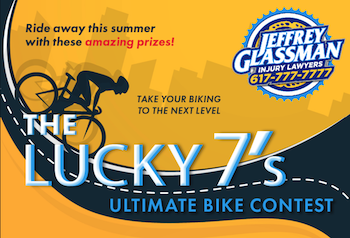Cycling At Night
Bicycling at night in Boston can be cathartic. The bustling traffic slows. The air cools. The city lights reflect off the waterfront.
But remember that in the dark, your bicycle reflectors and headlights look like brief blips of light to motorists. Many of those who bike at night overestimate how far a bright vest or a two-inch reflector is going to go in terms of visibility on the road.
At the Jeffrey Glassman Injury Lawyers's BikeAttorney.com, our Boston bicycle accident lawyers know there is much competition for a driver’s attention, and this is especially so at night. There are traffic lights, streetlights, oncoming headlights, brake lights, reflective signs and dashboard indicators.
The Boston Safe Cycling Report indicates there are three peak times at which Boston bicycle accidents happen: 7 a.m., noon and 5 p.m. This is consistent with rush-hour traffic. In the winter, it’s dark during the 7 a.m. rush hour.
Whether a cyclist is commuting to work or riding for leisure, their safety is something they must take seriously.
Massachusetts Law on Lighting
Mass. Gen. Law Ch. 85, Section 11B (8) and (9) details lighting requirements for bicyclists who choose to ride at night.
The statutes require that anyone operating a bicycle one-half hour after sunset and one half-hour after sunrise must:
- Have a bicycle lamp on the front of the bike that emits a white light at a distance of at least 500 feet;
- Have a red light OR red reflector on the rear of the bicycle that is visible for not less than 600 feet by a driver using low beam headlights directly behind the cyclist (generator lamps that activate when the bike is moving meets the statutory requirement);
- Have a reflector either on each pedal of the bike or around each of his or her ankles that is visible from the front and rear for a distance of 600 feet;
- Have reflectors or reflective material either on the bicycle or the cyclist on either side of the bike that is visible for at least 600 feet.
Bicyclists are free to have as many lights and reflectors as they want, but this is the minimum requirement. Many cycling enthusiasts recommend lighting yourself up like a Christmas tree. The point is to make sure drivers can see you. In so many of the bike injury cases we take, the driver’s first response to the collision was, “I didn’t see him/ her until it was too late.” This is not to say drivers are void of responsibility in these situations. Still, it’s a good idea for cyclists to make themselves hard to miss.
Another advantage for cyclists who use ample lighting is that they are better able to spot potential hazards in their path.
Think Like a DriverIn analyzing why it’s difficult for drivers to spot cyclists – even when they are using the proper lighting and reflective equipment – we have to understand human biology.
Our eyes have cones that allow us to see color in the daytime. At night, rods take over. They can’t see color, but they are highly sensitive to motion, and they are especially helpful with our peripheral vision. In both situations, bicyclists want to stand out as much as possible, and that means creating a contrast.
As this Boston Globe article explains, bright, fluorescent colors work well in the daytime because they catch the sun’s ultraviolet radiation. It doesn’t work like that at night. Reflectors help, but vision experts opine we need to rethink where we’re placing them.
Most people put reflectors on their heads, their torsos or the fenders of the bike. But those are fixed points. Our brain interprets well “biological motion,” so it’s best to place reflective tape, bands and stripes on the parts of our bodies that move when we cycle: The ankles, the arms, the wrists, the elbows, the knees and the feet. The idea is to give drivers as much indication that not only is there something ahead, but it’s a person and he’s moving in X-direction at Y-speed.
So in addition to lighting up your joints, it’s recommended that riders:
- Use reflectors on all sides of the bicycle, so that there is an opportunity for a driver’s headlights to catch the light, no matter the angle from which it is approaching.
- Don’t assume drivers can see you. If you can, make eye contact, particularly when you’re at intersections.
- Know they are not invincible just because they have lights. They have to be alert, riding defensively and obeying all pertinent traffic laws.
If you have been injured in a bicycle accident in Boston while riding at night, contact our experienced legal team to learn more about how we can help.
Contact the Boston Bicycle Accident Lawyers at Jeffrey Glassman Injury Lawyers's BikeAttorney.com.
 Jeffrey Glassman Injury Lawyers Home
Jeffrey Glassman Injury Lawyers Home



